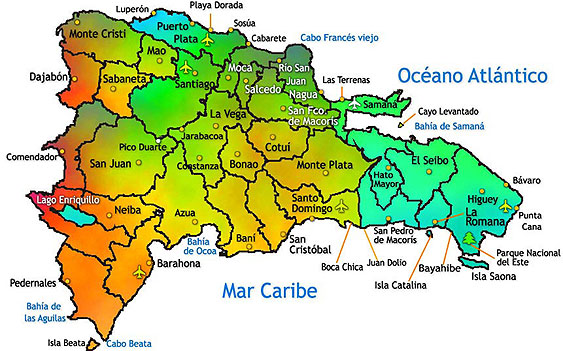
Country Facts
Capital : Santo Domingo de Guzmán
Population : 9,183,984 (July 2006)
Area : 48,464 sq. Km.
Currency : Dominican peso (RD$)
Independence : February 27, 1844
Government : Democratic Republic
Official Language: Spanish
Official Religion: Roman Catholic
National Bird : “Cigua Palmera”
National Flower : Flor de la Caoba
Founding Father : Juan Pablo Duarte
President : Lic. Danilo Medina Sánchez
Vice President : Dra. Margarita Cedeño de Fernández
Geography
The Dominican Republic is located in the Caribbean, between Cuba and Puerto Rico. With an extension of 48,442 square kilometers, the country is the second largest country in the Antilles. This strategic geographic position has turned it into the main tourist destination of the region and into an ideal place for business and trade.
The climate is semitropical, with an average annual temperature of 26°C (78°F).
The Dominican Republic has a great geographic diversity, having extensive beaches of white sand, fertile valleys with exuberant vegetation, desert zones with dune formations, mighty mountain chains where Pico Duarte, the highest peak and lake Enriquillo the biggest lake in the Caribbean.
The capital of the Dominican Republic is Santo Domingo. Other important cities are Santiago, San Pedro de Macorís, La Romana, Puerto Plata, Barahona, La Vega, San Francisco and Higuey.
Culture
Bartolomé Colón, Christopher Columbus’ brother, founded the Dominican capital, Santo Domingo de Guzmán, in August 5th, 1497. The city reveals a striking contrast between its Old World charm and its modernistic steel and concrete structures of the present century. The Colonial Zone, is the oldest part of the city and UNESCO declared it a World Heritage site. Among its most prominent structures are the Catedral Metropolitana de Santa María de la Encarnación, the oldest in America. The fortress-like castle of Columbus’ son, Diego, the Alcázar de Colón stands on a cliff overlooking the Caribbean.
The Tourism Factor
Tourism is, without doubt, one of the most important economic activities of the Dominican Republic and one of the fastest growing in the Caribbean.
The tourism boom has prompted a frenzy of hotel construction, particularly along the country’s northern coast, around Puerto Plata and Sosua and the southeastern coast, around Bavaro and Punta Cana. The latest estimates for the end of the year 2000, put the number of hotel rooms in the Dominican Republic at 52,000 – the largest in the Caribbean – with another 4,000 rooms under construction.
The availability of hotel rooms and modern facilities to accommodate different interests has helped to make tourism one of the country’s most important industries, earning more than US$2.4 billion on foreign exchange.
For further information, please visit one of the following sites: http://www.godominicanrepublic.com/ ; http://www.dominicanaonline.org; http://www.dominicanrepublic.com/ .
Museums
National museums celebrate all aspects of Dominican life in the past and present. They house treasures and artifacts from the world over. Among them are:
• Santo Domingo:
Museum of Dominican Man
Museum of Natural History
Museum of Dominican Family
Museum of Royal Houses
Pre-hispanic Art Museum
Viceroy Museum and Alcazar
Museum of Antique Coins
Gallery of Modern Art
Columbus Lighthouse
• Santiago:
Tomás Morel Folklore Museum
Cultural Center Eduardo León Jiménez
• Puerto Plata:
Amber Museum
• Altos de Chavón:
Archeological Museum
Language
Spanish is the official language. French, German, Italian and English are widely spoken in tourist areas. Traffic signs and most menus in restaurants are in Spanish.
Golf
The Dominican Republic is one of the premier golf destinations in the Caribbean. Thanks to the tropical climate golfers are able to play all year round. Whether you are a golf pro or wish to embark on this fascinating sport, the Dominican Republic offers plenty of choices thoughout the country.
The majority of the golf courses are found along the coast in the country's burgeoning resorts. Each resort has been developed in tune with the coastline and other natural elements incorporated into the design. There are over 20 golf courses waiting for you to enjoy and more are soon to open. Golf is one of the Dominican Republic's top attractions.
Holidays in the Dominican Republic
Jan 1 : New Year’s Day
Jan. 6 : Epiphany
Jan. 21 : Virgin Altagracia
Jan. 26 : Birthday of Juan Pablo Duarte (Founding Father of the Nation)
Feb. 27 : Independence Day
Variable :Good Friday
May. 1 : Labor Day
Variable :Day of Corpus Christi
Aug. 16 : Restoration of Independence
Sept. 24 :Virgin Mercedes
Nov. 6 : Constitution Day
Dec. 25 : Christmas Day
Currency
The Dominican Peso is freely exchangeable to the dollar and other major currencies.
For the daily exchange rate visit: www.bancentral.gov.do
In order to obtain a visa to visit the Dominican Republic, you require a valid passport, and a petition letter when not requested in person.
Students should present a proof of admission from the University in which they have been registered.
Most of the visas should be approved by the Secretariat of State of Foreign Affairs in Santo Domingo.
For further information, please call the Consulate General of the Dominican Republic in New York. Main phone: (212) 768-2480, Visa section, ext. 1003. Website: www.consuladord-ny.org .
Documents:

